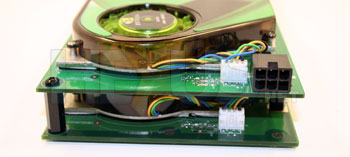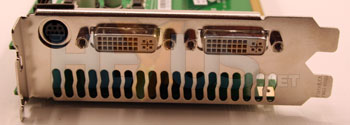Reference Board Exam
Awwww, isn't it cute? Just 230mm or so long, it's a fair chunk shorter than the initial dual-PCB boards used in the first Quad SLI attempt. The top PCB you can see is mostly mirrored underneath, with the exceptions of no power connector (just one is needed for the entire board) and the SLI connector for running Quad SLI when that's supported. The following pics show you both things, and more.
You can see the DVI ports, both dual-link and HDCP-protected (really, with the board containing the crypto hardware needed), are connected to and controlled by the G71 on the top PCB. Does that make the 7950 GX2 NVIDIA's first HDCP-supporting board? Maybe not, but it's instantly going to become the most well known of any that do exist.
Without the time to have a go at full disassembly like we usually do, we can't show you the DRAMs, but we suspect they're BJ11 Samsung GDDR3 parts rated to over 800MHz. And remember there's 512MiB per GPU, for 1GiB total (although it's a not an addressable-by-both-GPUs-arbitrarily total, as you know).
The bottom PCB layer gets some holes for hot air to make its way out of your chassis, but it's a crying shame that doesn't really happen. The coolers employed mean the one retained to the GPU on the bottom layer isn't best setup to take advantage of the exhaust opportunity.
Consequently, the bottom PCB gets very very hot, verified by our calibrated thermometer to be approaching 90°C under usual gaming load on the back side of the board, at stock clocks. That heat then spreads across the PCB, sinked across to the backplane which also gets far too hot to touch after extended load.
We're confident in saying that the cooler on the bottom GPU is simply unable to do the best job, given the space constraints and the way it works, meaning you seriously need a very well ventilated chassis to run a single 7950 GX2 reliably, never mind two when that becomes doable.
So while NVIDIA are apparently happy with up to 122°C for the GPU temperatures (whether that's for one GPU or both we don't know), letting the PCB heat up to somewhere approaching that, which is what we've seen happen under load, probably isn't a good idea.
Noise wise, things are worse than a 7900 GTX, but appreciably tolerable and much better than what you suffer with a dual-slot ATI graphics board. No complaints there. Swapping out to a 3rd party cooling solution is, well, largely impossible.
As for power consumption, we don't have figures to present, but it's more than what a pair of 7900 GTs ask for. Let's chat integration and drivers, before a look at comparative performance.













